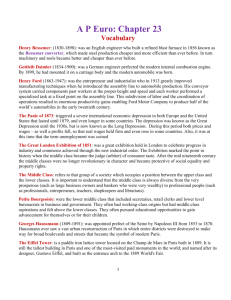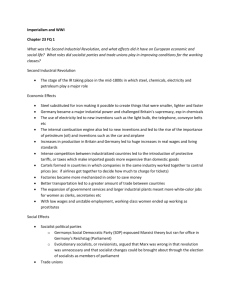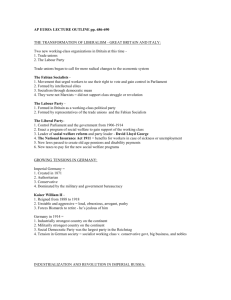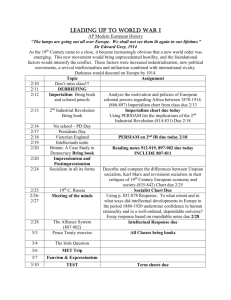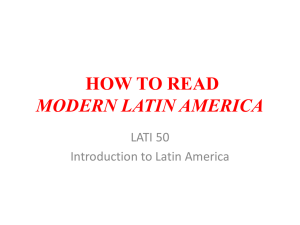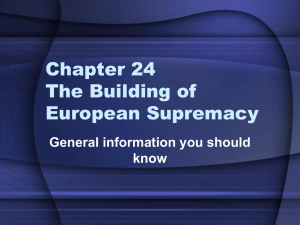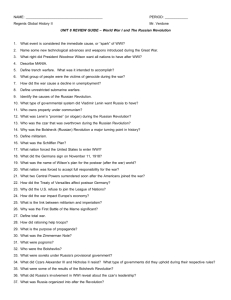Chapter 23 Study Guide Population Tren
advertisement
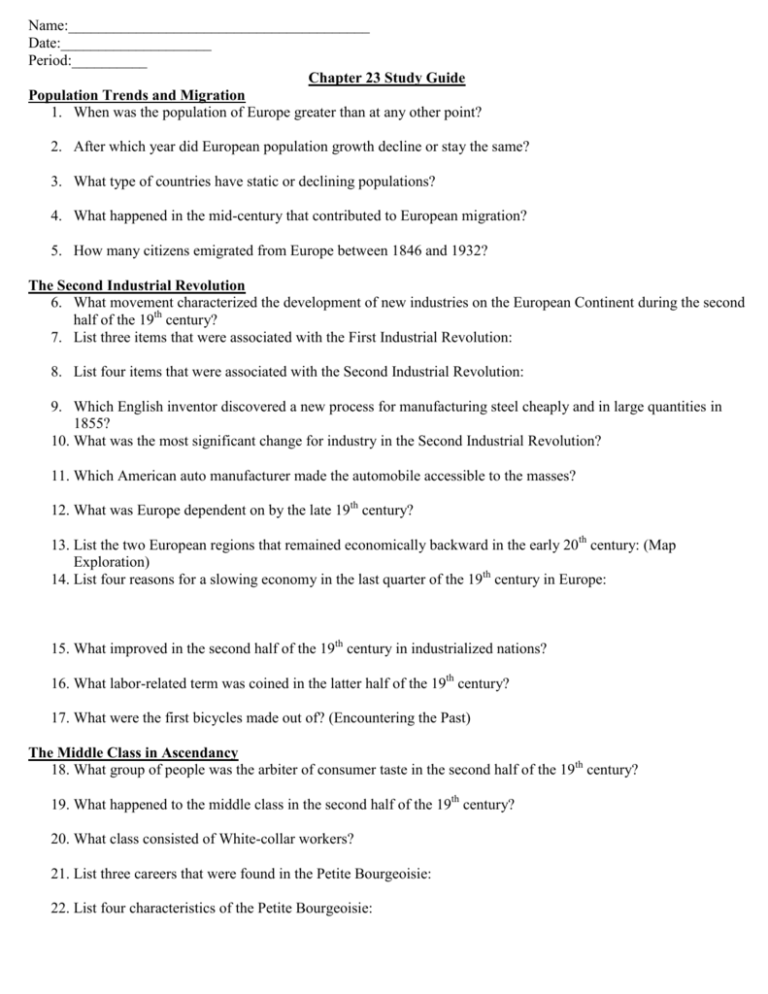
Name:________________________________________ Date:____________________ Period:__________ Chapter 23 Study Guide Population Trends and Migration 1. When was the population of Europe greater than at any other point? 2. After which year did European population growth decline or stay the same? 3. What type of countries have static or declining populations? 4. What happened in the mid-century that contributed to European migration? 5. How many citizens emigrated from Europe between 1846 and 1932? The Second Industrial Revolution 6. What movement characterized the development of new industries on the European Continent during the second half of the 19th century? 7. List three items that were associated with the First Industrial Revolution: 8. List four items that were associated with the Second Industrial Revolution: 9. Which English inventor discovered a new process for manufacturing steel cheaply and in large quantities in 1855? 10. What was the most significant change for industry in the Second Industrial Revolution? 11. Which American auto manufacturer made the automobile accessible to the masses? 12. What was Europe dependent on by the late 19th century? 13. List the two European regions that remained economically backward in the early 20th century: (Map Exploration) 14. List four reasons for a slowing economy in the last quarter of the 19th century in Europe: 15. What improved in the second half of the 19th century in industrialized nations? 16. What labor-related term was coined in the latter half of the 19th century? 17. What were the first bicycles made out of? (Encountering the Past) The Middle Class in Ascendancy 18. What group of people was the arbiter of consumer taste in the second half of the 19th century? 19. What happened to the middle class in the second half of the 19th century? 20. What class consisted of White-collar workers? 21. List three careers that were found in the Petite Bourgeoisie: 22. List four characteristics of the Petite Bourgeoisie: Late-19th-Century Urban Life 23. What did municipal governments do to central portions of large European cities? 24. List four activities that dominated central cities: 25. Who did Napoleon III appoint to redesign Paris? 26. Why were the streets widened in Paris? 27. What was the name of the major public building where operas were performed? 28. What was built in Paris in 1889 for the international trade exposition? 29. What religious building was constructed between 1873 and 1914 by the Roman Catholic Church as an act of national penance for the sins that had supposedly led to French defeat in the Franco-Prussian War? 30. Where did the middle-class look for housing? 31. What name was given to communities living outside of city centers that often consisted of apartment buildings or private houses built closely together with small gardens? 32. List four reasons for the development of suburbs: 33. What new forms of travel transformed city transformation? 34. Which epidemic struck all classes in the 19th century? 35. Which European city had the largest population in 1910? 36. List the three scientists discovered the bacterial theory of disease: 37. Which group of reformers targeted the issue of housing conditions as an impediment to a healthy and stable population? Varieties of Late-19th-Century Women’s Experiences 38. Which European country was first to allow women to own property? 39. List two major developments affecting the economic lives of women during the Second Industrial Revolution: 40. In which country were mass-made clothes tailored in the home by independent workers? 41. What is this system called? 42. Which cult shaped the lives of middle-class women? 43. List three characteristics of a typical 19th century middle-class woman: Jewish Emancipation 44. What European political ideology emancipated European Jews and offered them equal citizenship? 45. Whose lives and opportunities were enhanced after the Revolutions of 1848? 46. What European Jews suffered more than any other due to political repression and pogroms? 47. What was the most famous wealthy Jewish family that controlled banks in several countries? (caption) 48. What economic ideology did many Eastern European Jews adopt in the late 19th-century? 49. What movement was initially a minority movement within the Jewish community and sought to establish a country only for Jews? Labor, Socialism and Politics to World War I 50. List the years of legalization of trade unions among their respective states: Britain- France- Germany- 51. Which French leader allowed the establishment of weak labor unions as his power waned in 1868? 52. Which country did NOT adapt a broad-based electoral system in the 19th century? 53. What economic system opposed nationalism and sought to unite the working classes across national borders? 54. What was the primary issue that confronted socialists in the late 19th century? 55. Which organization was established in 1864 and was closely associated with Karl Marx? 56. What was this organizations full name? 57. What did this organization impact? 58. What emerged as the sing most important strand of socialism in the 19th century? 59. Which socialist party was established by the Trades Union Congress in 1906? 60. What was established in 1884 and became Britain’s most influential socialist group? 61. List five key members of the Fabian Society: 62. Which three words are used in regards to how Fabian Socialists seek to create a socialist nation? 63. How did they plan on forwarding their socialist views? 64. What act of Parliament provided unemployment benefits and healthcare in 1911? 65. Which act allowed the House of Commons to override the legislative veto of the House of Lords? 66. What socialist organization was founded in 1889 to unify the various national socialist parties and trade unions? 67. What movement in France was divided with two main opposing factions? 68. Who usually voted for socialists in France? 69. Who started the German Social Democratic Party (SPD) in 1875? 70. Who believed socialism would undermine German politics and society and persecuted the SPD? 71. Who was the target in an assassination attempt in 1878 which resulted in the passage of many antisocialist laws in Germany? 72. List four measures taken by Otto von Bismarck in response to the efforts of the German socialists: 73. Who became the emperor of Germany in 1888 and forced Bismarck’s resignation mainly because of differences over foreign policy? 74. Who argued that German socialists should focus on improving the lives of German workers? 75. Who wrote Evolutionary Socialism in 1899 and promoted social reform through the use of democracy? 76. What strategy was adopted by 19th-century German socialists to create a socialist state through the evolution of democratic institutions and not revolution? 77. What country was one of the last major European countries to industrialize and entered the industrial age in the 1890s? 78. Which figure was most responsible for Russia’s Industrialization? 79. List four aspects of Sergei Witte’s policy of planned economic development: 80. What 5,000-mile-long railroad stretched across Russia and was completed in 1903? 81. What is the Russian term for prosperous peasant farmers? 82. What socialist revolutionary party was established in 1898? 83. Who became the future leader of the communist revolution in Russia and wrote What Is to Be Done in 1902? 84. List two things that are criticized or rejected in What Is to Be Done?: 85. List two things that are advocated in What Is to Be Done?: 86. What socialist faction was led by Vladimir Lenin? 87. What does the name of this faction mean in Russian? 88. What name did Lenin apply to the majority moderate faction of the Russian Social Democratic Party that was opposed to him and the Bolsheviks? 89. What does the name of this faction mean in Russian? 90. What socialist faction took control of the Social Democratic Party at the London Congress of the Russian Social Democratic Party in 1903? 91. List the two principles that Lenin outlined in his book Two Tactics of Social Democracy in the BourgeoisDemocratic Revolution that was written in 1905: 92. In what year did the Bolsheviks seize power in Russia thus transforming the political landscape of the 20th century? 93. What country did Russia go to war against in hopes of acquiring territory and to rally public opinion for the tsar in 1904? 94. What name is given to the event in St. Petersburg in which peaceful demonstrators were gunned down by the Imperial Guard? 95. What revolution broke out as a result of this tragedy? 96. Who agreed to establish a representative body in Russia after the events of 1905 thus bringing Russia closer to a constitutional monarchy? 97. What name was given to the Russian parliament that was established in 1906? 98. Who had gained ascendancy with the tsar and his wife because of his alleged power to heal the tsar’s son? 99. Who was the son of Nicholas II and heir to the Russian throne? 100. What disease did the heir suffer from?

